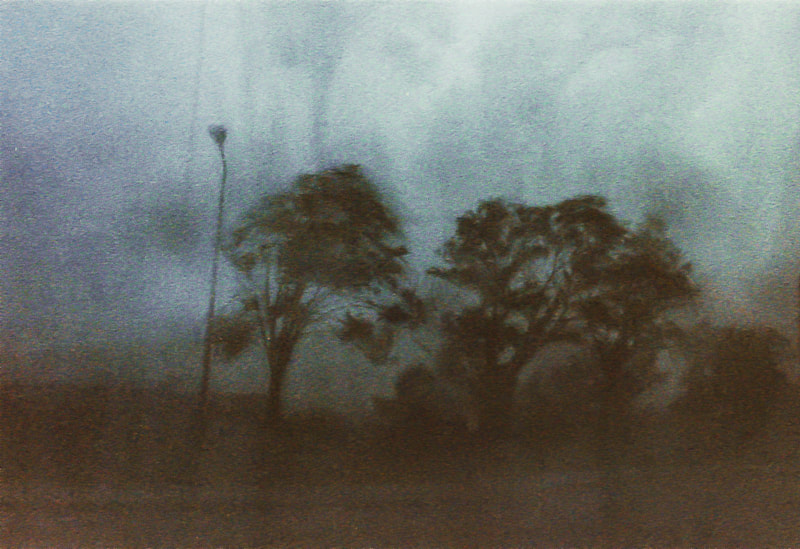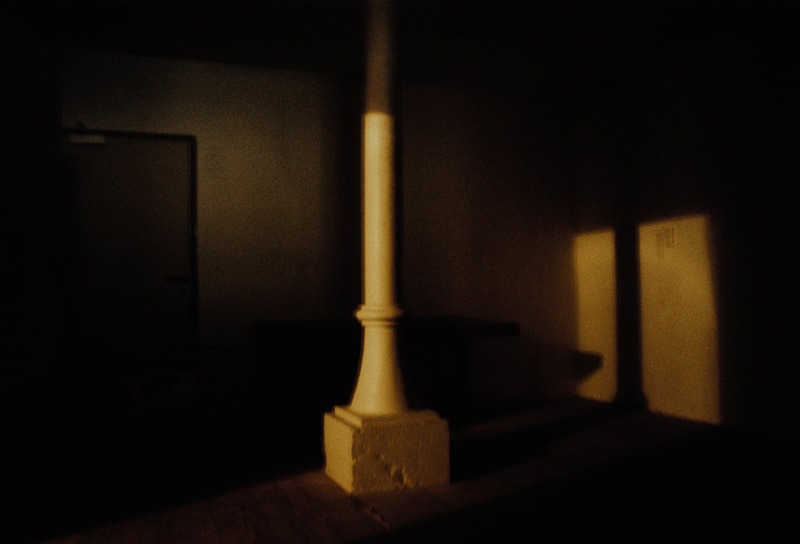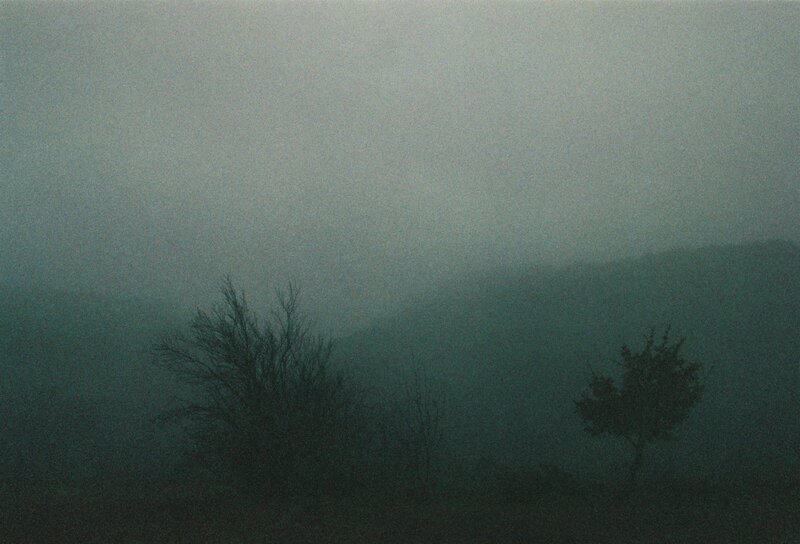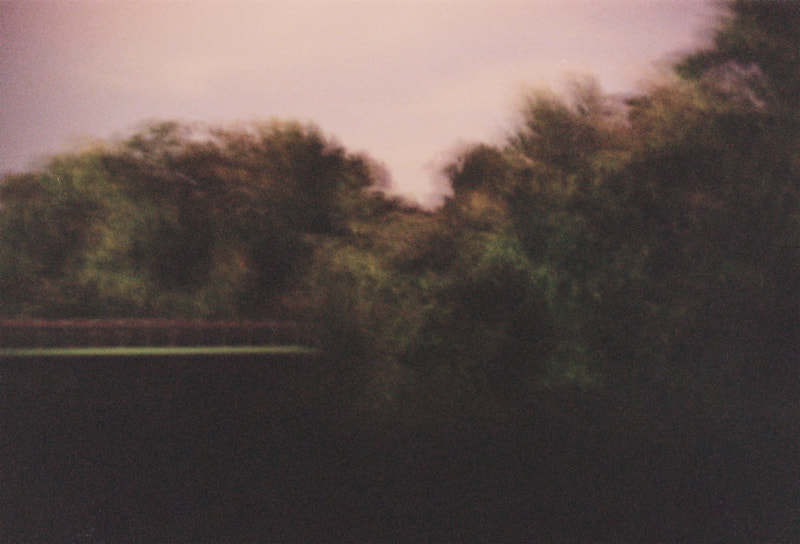Des soleils maladroits-Clumsy suns-En partenariat avec Pollen, résidence d’artistes à Monflanquin.
Les photographies présentées ici sont plus que des images, elles sont une vie.
Régis Feugère est de ces artistes qui ne font aucune différence, aucun écart, pas même de l’épaisseur d’une feuille de cigarette, entre leur vie et leur travail. En exposant, ce photographe s’expose en montrant son intimité, plus précisément ses états contemplatifs. Son engagement artistique est franc : une photographie doit être une source et l’accomplissement d’une démarche personnelle faite de réflexion et d’intuition.
In-tuire dit le latin, littéralement, l’intuition désigne tout autant une faculté qu’une démarche où il s’agit d’oublier son intelligence et les mots qui vont avec afin de se mettre au contact immédiat avec la chose même. Pour cet artiste, la chose est entendue : par-delà sa dimension technique, l’art photographique recèle un caractère éminemment intuitif et c’est cette dimension que Régis Feugère s’efforce de cultiver. Et ce n’est pas si aisé, c’est même paradoxal : aucun protocole préétabli, à peine un dispositif, plutôt un processus créant les conditions de possibilité afin que l’intuition puisse s’exprimer. Ce processus commence simplement : partir à pied de nuit jusqu’au petit matin sans plan ni formule à appliquer si ce n’est l’exploration d’un territoire. Marcher au hasard durant un long moment d’égarement jusqu’à ce qu’une chose vous fasse signe et vous surprenne. Alors attraper la chose au juger, appuyer sur le bouton jusqu’à ce que le déclenchement s’en suive ; surtout déclencher avant de se représenter ce qui va être enregistré : à la volée. L’image de la mouette prise en train de voler, flotter, nager dans un ciel crépusculaire a été produite selon ce processus. De cette éthique découle naturellement une esthétique. La bonne photographie ne nécessite aucune maîtrise complète mais doit évoquer un léger laisser-aller qui permet d’admettre et d’accueillir une certaine imperfection comme un petit défaut ou un léger boitement. Une image réussie est en fin de compte une présence authentique, celle qui signe la présence au monde de l’artiste. Il ne s’agit pas de créer un visuel mais de rendre visible une présence, de la manifester de telle manière qu’une photographie doit égratigner le réel en apportant une nouvelle image au monde.
Pierre J. Truchot.
https://www.pollen-monflanquin.com/
Pierre J. Truchot est docteur en philosophie de l’Université Paris 1 Panthéon-Sorbonne et chercheur au laboratoire FoRell « Poétiques de la représentation » de l’Université de Poitiers. Sa thèse peut ses résumer en une histoire de la peinture occidentale à la lumière des concepts de mouvement et de temps. Il est l’auteur de nombreux articles portant sur la pensée et l’esthétique de Bergson, sur les rapports entre textes et images et sur la philosophie de l’art au XVIII ème siècle. Il écrit également sur l’art contemporain en collaboration avec des artistes comme Bruno Serralongue, Julien Berthier, Vincent Ganivet. D’autres publications portent sur les serious games et les art games. Auteur de deux ouvrages aux éditions Marguerite Waknine Le théorème de Staël et Paul Bril, deux éternités. Lauréat d’une bourse du CNL en 2014, il a publié un essai intitulé L’art (d’être) idiot qui a été publié aux éditions L’Harmattan en 2018. Récemment il a publié son deuxième essai consacré à l’oubli, L’art d’oublier, toujours aux éditions L’Harmattan. Il vit à Angoulême et est professeur de philosophie.
The photographs presented here are more than images, they are a life.
Régis Feugère is one of those artists who make no difference, no gap, not even the thickness of a cigarette leaf, between their life and their work. By exhibiting, this photographer exposes himself by showing his intimacy, more precisely his contemplative states. His artistic commitment is frank: a photograph must be a source and the accomplishment of a personal process made up of reflection and intuition.
In-tuire says the Latin, literally, intuition designates as much a faculty as a process where it is a question of forgetting one's intelligence and the words that go with it in order to put oneself in immediate contact with the thing itself. For this artist, the thing is understood: beyond its technical dimension, photographic art conceals an eminently intuitive character and it is this dimension that Régis Feugère strives to cultivate. And it's not so easy, it's even paradoxical: no pre-established protocol, barely a device, rather a process creating the conditions of possibility so that intuition can express itself. This process begins simply: setting out on foot at night until the early hours of the morning with no plan or formula to apply except the exploration of a territory. Walk randomly for a long moment of bewilderment until something beckons and surprises you. So grab the judging thing, press the button until the trigger ensues; especially trigger before imagining what is going to be recorded: on the fly. The image of the seagull caught flying, floating, swimming in a twilight sky was produced using this process. From this ethics naturally flows an aesthetic. Good photography does not require complete mastery but must evoke a slight letting go that allows you to admit and welcome a certain imperfection such as a small defect or a slight limp. A successful image is ultimately an authentic presence, one that signs the presence in the world of the artist. It is not a question of creating a visual but of making a presence visible, of manifesting it in such a way that a photograph must scratch reality by bringing a new image to the world.
Pierre J. Truchot.
Pierre J. Truchot is a doctor of philosophy from the University of Paris 1 Panthéon-Sorbonne and a researcher at the FoRell laboratory "Poetics of representation" at the University of Poitiers. His thesis can be summed up in a history of Western painting in the light of the concepts of movement and time. He is the author of numerous articles on the thought and aesthetics of Bergson, on the relationship between texts and images and on the philosophy of art in the 18th century. He also writes on contemporary art in collaboration with artists such as Bruno Serralongue, Julien Berthier, Vincent Ganivet. Other publications focus on serious games and art games. Author of two books published by Marguerite Waknine, Stael’s theorem and Paul Bril, two eternities. Winner of a CNL grant in 2014, he published two essays The art of being an Idiot and The art of forgetting published by L’Harmattan in 2018 and 2022.
He lives in Angoulême and is a professor of philosophy.
Régis Feugère est de ces artistes qui ne font aucune différence, aucun écart, pas même de l’épaisseur d’une feuille de cigarette, entre leur vie et leur travail. En exposant, ce photographe s’expose en montrant son intimité, plus précisément ses états contemplatifs. Son engagement artistique est franc : une photographie doit être une source et l’accomplissement d’une démarche personnelle faite de réflexion et d’intuition.
In-tuire dit le latin, littéralement, l’intuition désigne tout autant une faculté qu’une démarche où il s’agit d’oublier son intelligence et les mots qui vont avec afin de se mettre au contact immédiat avec la chose même. Pour cet artiste, la chose est entendue : par-delà sa dimension technique, l’art photographique recèle un caractère éminemment intuitif et c’est cette dimension que Régis Feugère s’efforce de cultiver. Et ce n’est pas si aisé, c’est même paradoxal : aucun protocole préétabli, à peine un dispositif, plutôt un processus créant les conditions de possibilité afin que l’intuition puisse s’exprimer. Ce processus commence simplement : partir à pied de nuit jusqu’au petit matin sans plan ni formule à appliquer si ce n’est l’exploration d’un territoire. Marcher au hasard durant un long moment d’égarement jusqu’à ce qu’une chose vous fasse signe et vous surprenne. Alors attraper la chose au juger, appuyer sur le bouton jusqu’à ce que le déclenchement s’en suive ; surtout déclencher avant de se représenter ce qui va être enregistré : à la volée. L’image de la mouette prise en train de voler, flotter, nager dans un ciel crépusculaire a été produite selon ce processus. De cette éthique découle naturellement une esthétique. La bonne photographie ne nécessite aucune maîtrise complète mais doit évoquer un léger laisser-aller qui permet d’admettre et d’accueillir une certaine imperfection comme un petit défaut ou un léger boitement. Une image réussie est en fin de compte une présence authentique, celle qui signe la présence au monde de l’artiste. Il ne s’agit pas de créer un visuel mais de rendre visible une présence, de la manifester de telle manière qu’une photographie doit égratigner le réel en apportant une nouvelle image au monde.
Pierre J. Truchot.
https://www.pollen-monflanquin.com/
Pierre J. Truchot est docteur en philosophie de l’Université Paris 1 Panthéon-Sorbonne et chercheur au laboratoire FoRell « Poétiques de la représentation » de l’Université de Poitiers. Sa thèse peut ses résumer en une histoire de la peinture occidentale à la lumière des concepts de mouvement et de temps. Il est l’auteur de nombreux articles portant sur la pensée et l’esthétique de Bergson, sur les rapports entre textes et images et sur la philosophie de l’art au XVIII ème siècle. Il écrit également sur l’art contemporain en collaboration avec des artistes comme Bruno Serralongue, Julien Berthier, Vincent Ganivet. D’autres publications portent sur les serious games et les art games. Auteur de deux ouvrages aux éditions Marguerite Waknine Le théorème de Staël et Paul Bril, deux éternités. Lauréat d’une bourse du CNL en 2014, il a publié un essai intitulé L’art (d’être) idiot qui a été publié aux éditions L’Harmattan en 2018. Récemment il a publié son deuxième essai consacré à l’oubli, L’art d’oublier, toujours aux éditions L’Harmattan. Il vit à Angoulême et est professeur de philosophie.
The photographs presented here are more than images, they are a life.
Régis Feugère is one of those artists who make no difference, no gap, not even the thickness of a cigarette leaf, between their life and their work. By exhibiting, this photographer exposes himself by showing his intimacy, more precisely his contemplative states. His artistic commitment is frank: a photograph must be a source and the accomplishment of a personal process made up of reflection and intuition.
In-tuire says the Latin, literally, intuition designates as much a faculty as a process where it is a question of forgetting one's intelligence and the words that go with it in order to put oneself in immediate contact with the thing itself. For this artist, the thing is understood: beyond its technical dimension, photographic art conceals an eminently intuitive character and it is this dimension that Régis Feugère strives to cultivate. And it's not so easy, it's even paradoxical: no pre-established protocol, barely a device, rather a process creating the conditions of possibility so that intuition can express itself. This process begins simply: setting out on foot at night until the early hours of the morning with no plan or formula to apply except the exploration of a territory. Walk randomly for a long moment of bewilderment until something beckons and surprises you. So grab the judging thing, press the button until the trigger ensues; especially trigger before imagining what is going to be recorded: on the fly. The image of the seagull caught flying, floating, swimming in a twilight sky was produced using this process. From this ethics naturally flows an aesthetic. Good photography does not require complete mastery but must evoke a slight letting go that allows you to admit and welcome a certain imperfection such as a small defect or a slight limp. A successful image is ultimately an authentic presence, one that signs the presence in the world of the artist. It is not a question of creating a visual but of making a presence visible, of manifesting it in such a way that a photograph must scratch reality by bringing a new image to the world.
Pierre J. Truchot.
Pierre J. Truchot is a doctor of philosophy from the University of Paris 1 Panthéon-Sorbonne and a researcher at the FoRell laboratory "Poetics of representation" at the University of Poitiers. His thesis can be summed up in a history of Western painting in the light of the concepts of movement and time. He is the author of numerous articles on the thought and aesthetics of Bergson, on the relationship between texts and images and on the philosophy of art in the 18th century. He also writes on contemporary art in collaboration with artists such as Bruno Serralongue, Julien Berthier, Vincent Ganivet. Other publications focus on serious games and art games. Author of two books published by Marguerite Waknine, Stael’s theorem and Paul Bril, two eternities. Winner of a CNL grant in 2014, he published two essays The art of being an Idiot and The art of forgetting published by L’Harmattan in 2018 and 2022.
He lives in Angoulême and is a professor of philosophy.











































